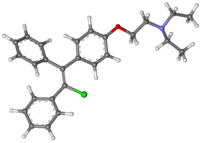Clomifene
 |
|
 |
|
| Clinical data | |
|---|---|
| Trade names | Clomid, others |
| AHFS/Drugs.com | Monograph |
| Pregnancy category |
|
| Routes of administration |
by mouth |
| ATC code | |
| Legal status | |
| Legal status | |
| Pharmacokinetic data | |
| Bioavailability | High (>90%) |
| Metabolism | liver (with enterohepatic circulation) |
| Biological half-life | 5-7 days |
| Excretion | mainly kidney, some biliary |
| Identifiers | |
|
|
| CAS Number | |
| PubChem CID | |
| IUPHAR/BPS | |
| DrugBank | |
| ChemSpider | |
| UNII | |
| KEGG | |
| ChEBI | |
| ChEMBL | |
| ECHA InfoCard | 100.011.826 |
| Chemical and physical data | |
| Formula | C26H28ClNO |
| Molar mass | 406 or 598.10 g/mol (with citrate) |
| 3D model (Jmol) | |
|
|
|
|
|
|
|
Clomifene, also known as clomiphene, is a medication used to treat infertility in women who do not ovulate. This includes those who have polycystic ovary syndrome. Use results in a greater chance of twins. It is taken by mouth once a day.
Common side effects include pelvic pain and hot flushes. Other side effects can include changes in vision, vomiting, trouble sleeping, ovarian cancer, and seizures. It is not recommended in people with liver disease or who are pregnant. Clomifene is in the selective estrogen receptor modulator (SERM) family of medication. It works by causing the release of gonadotrophin by the hypothalamus.
Clomifene was approved for medical use in the United States in 1967. It is on the World Health Organization's List of Essential Medicines, the most effective and safe medicines needed in a health system. It is available as a generic medication. The wholesale cost in the developing world is about 0.79 to 2.00 USD for a course of treatment. In the United States the wholesale cost of a course of treatment is 4.80 USD. Its introduction began the era of assisted reproductive technology.
Clomifene is useful in those who are infertile due to anovulation or oligoovulation. Evidence is lacking for the use of clomifene in those who are infertile without a known reason. In such cases, studies have observed a clinical pregnancy rate 5.6% per cycle with clomifene treatment vs. 1.3%–4.2% per cycle without treatment.
...
Wikipedia
